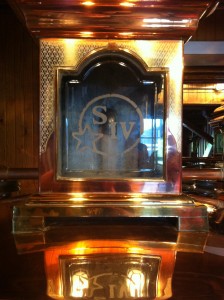1. Proof: In the US, the proof value of a spirit is stated at double its alcohol content. According to a story distillery tour guides tell, farmers distilled whiskey to 50% alcohol by volume and sold or traded it by the barrel before the days of bottling. Those accepting whiskey as payment tested to prove it was genuine by mixing it with a small amount of gunpowder. If the mixture burned with a bright blue flame, that was 100% proof it was 50% alcohol. If it wouldn’t burn it had too much water and was “under proof,” and if it burned too quickly it had too much alcohol and was “over proof.”
But the science of this story isn’t exactly true. For gunpowder to burn in this fashion, a spirit’s alcohol content must be slightly over 57%, thus 100 proof is actually about 57% alcohol. This standard is used in Britain but the US continues to state proof as twice the alcohol content.
2. Moonshiner: The one who makes illegal spirits. A bootlegger transports them by land; a rumrunner transports them by water. A “bootleg” was a curved flask that fit in the top of a riding boot.
3. Bottled in Bond: The so-named Act of 1897 created quality standards for bourbon whiskey. Much whiskey sold at the time was poorly made and some perceived a need for verifiable quality assurance. The Act stated a bottle could be labeled “bottled in bond” or “bonded” if the whiskey was made during one distilling season (a calendar year) by one distiller at one distillery. It had to be aged in a federally bonded warehouse under US government supervision for at least four years and bottled at 50% alcohol by volume. The label had to identify the originating distillery and, if different, where it was bottled. Only spirits produced in the US could be designated as bonded.
Distilleries of the day participated because they were allowed to delay payment of excise tax on stored whiskey until aging was complete. Treasury agents supervised the warehouse to ensure proper accounting and eventual collection of tax. Distilleries today consider this designation archaic and do not use it. Their warehouses are still bonded but competition to produce high-grade products for more discriminating consumer tastes has brought about excellent internal quality standards.
4. Whiskey year: The time between October harvest and April planting when farmers processed excess grains and distilled them into whiskey. Until modern times this cycle was followed by all distilleries and even now there is a “silent season,” (August) when many distilleries are closed.
5. Chill filtering: George Dickel observed that whiskey bottled in the winter was better than that made in the summer, and concluded that more sediment was removed when whiskey was filtered at lower temperatures. Chill-filtering prevents whiskey from becoming hazy when in the bottle, when served, or when water or ice is added. Such clouding only happens at 46% alcohol or less, thus stronger bottled whiskey is not chill-filtered. The process can sometimes affect the taste of the whiskey, such as by removing peat particles that contribute to the “smokiness” of the flavor, so some distilleries pride themselves on not using this process.
6. Spirit safe: A padlocked, brass-framed, glass-walled box attached to each still in a distillery. It allows the distiller to analyze and measure spirits being made without coming into contact with the spirit itself. It also prevents siphoning off spirits before their quantity is measured. The distillery manager and a Customs and Excise officer hold keys to the padlock.
7. Sweating the barrel: Whiskey remains in the wood after a barrel has been emptied. Some of it can be extracted by adding distilled water to the barrel and sealing it, then patiently rolling it around in the sun a few minutes every day for a month. Keeping the barrel’s inside wet encourages whiskey deep in the oak to flavor the distilled water, thus creating a spirit with gradually strengthening color, flavor, and alcohol content. One of the Beam boys discovered this when he was 13 years old, much to his mother’s consternation. Jim Beam Distillery uses a more advanced version of the technique to make its product Devil’s Cut.

